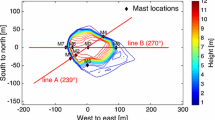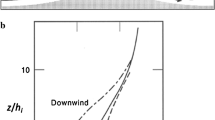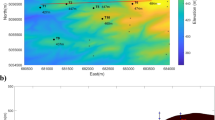Abstract
The U.S. Department of Energy (DOE) Atmospheric Studies in Complex Terrain (ASCOT) program began in the fall of 1978 as a multiple DOE and other Federal Laboratory program devoted to developing a better physical understanding of atmospheric boundary layer flows in areas of complex terrain. The first technical challenge undertaken by the program was an investigation of atmospheric boundary layer phenomena associated with the development, continuation and breakup of nocturnal drainage wind flows. This paper discusses the general objectives the program has addressed during the past several years and focuses on results from a major field experiment conducted in 1980 in The Geysers area of northern California. Specifically, results from measurements of simultaneous tracer releases are compared to calculations from a mass-consistent wind field model coupled to a particle-in-cell transport and diffusion model. Results of these comparisons show that model calculations agree with measurements within a factor of 5 approximately 50 percent of the time. Part of the difficulty faced by the models in these comparison studies is associated with large variabilities between measurements made by samplers located one or two δx apart when compared to the resolution of the models. Space and time averaging improves the comparisons considerably, although the design of the field experiment did not allow the determination of optimum spacial and temporal averages.
Similar content being viewed by others
References
Cowan, G. A., Ott, D. G., Turkevich, A., Machta, L., Ferber, G. J., and Daly, N. R.: 1976, ‘Heavy Methanes as Atmospheric Tracers’, Science 191, 1048–1050.
Dickerson, M. H. and Gudiksen, P. H.: 1980, ‘ASCOT FY-1980 Progress Report’, University of California Lawrence Livermore National Laboratory, UCID-18878.
Dickerson, M. H. and Gudiksen, P. H.: 1984, ‘Atmospheric Studies in Complex Terrain Technical Progress Report, FY1979 through FY1983’, University of California Lawrence Livermore National Laboratory, UCID-19851.
Eberhard, W.: 1981, ‘Field Measurements in Support of Dispersion Modeling in Complex Terrain — Annual Report 1980’, NOAA Technical Memorandum ERL WPL-78, NOAA Wave Propagation Laboratory, Boulder, CO.
Ferber, G. J., Telegadas, K., Heffter, J. L., Dickson, C. R., Dietz, R. N., and Krey, P. W.: 1981, ‘Demonstration of a Long Range Atmospheric Tracer System Using Perfluorocarbons’, NOAA Technical Memorandum ERL ARL-101, NOAA Air Resources Laboratories, Silver Spring, MD.
Fosberg, M. A., and Lanham, L. M.: 1983, ‘Above-Canopy Dispersion in Nighttime Downslope Flow’, Presented at Seventh Conference on Fire and Forest Meteorology, American Meteorological Society, April 25–29, 1983, Ft. Collins, CO.
Fowler, M.: 1979, ‘Methane Tracer System Development’, Proceedings of the Atmospheric Tracers and Tracer Application Workshop, LA-8144-C, Los Alamos Scientific Laboratory, Los Alamos, New Mexico.
Gudiksen, P. H.: 1983, ‘ASCOT Data from 1980 Field Measurement Program in the Anderson Creek Valley’, California, University of California Lawrence Livermore National Laboratory, UCID-18874-80, Vol. 1, 2, and 3.
Gudiksen, P. H., Ferber, G. J. Fowler, M. M., Eberhard, W. L., Fosberg, M. A., and Knuth, W. R.: 1983, ‘Field Studies of Transport and Dispersion of Atmospheric Tracers in Nocturnal Drainage Flows’, University of California Lawrence Livermore National Laboratory, UCRL-88931. To be published in Atmospheric Environment.
Gudiksen, P. H. and Dickerson, M. H.: 1984, ‘Executive Summary: Atmospheric Studies in Complex Terrain Technical Progress Report, FY1979 through FY1983’, University of California Lawrence Livermore National Laboratory, UCID-18878-83 Summary.
Lange, R.: 1978, ‘ADPIC - A Three-Dimensional Particle-in-Cell Model for the Dispersal of Atmospheric Pollutants and its Comparison to Regional Tracer Studies’, J. Appl. Meteor. 17, 320–329.
Lovelock, J. E., and Ferber, G. J.: 1982, ‘Exotic Tracers for Atmospheric Studies’, Atmospheric Environment 16, 1467–1471.
Porch, W. M. and Lange, R.: “Spatially Averaging Cross-Wind Sensors and Numerical Model Results for Nocturnal Drainage Winds in Complex Terrain”, University of California Lawrence Livermore National Laboratory, UCRL-87797.
Sherman, C. A.: 1978, ‘A Mass-Consistent Model for Wind Fields Over Complex Terrain’, J. Appl. Meteor. 17, 312–319.
Author information
Authors and Affiliations
Rights and permissions
About this article
Cite this article
Dickerson, M.H., Foster, K.T. & Gudiksen, P.H. Experimental and model transport and diffusion studies in complex terrain with emphasis on tracer studies. Boundary-Layer Meteorol 30, 333–350 (1984). https://doi.org/10.1007/BF00121960
Issue Date:
DOI: https://doi.org/10.1007/BF00121960




